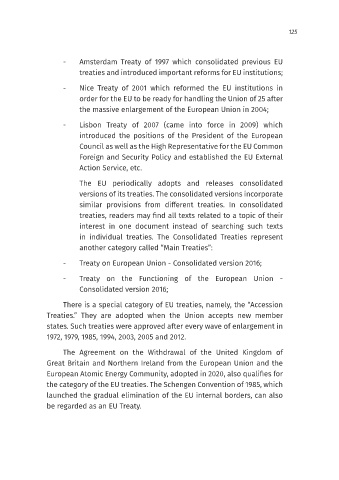Page 126 - SEVEN STEPS for COMPREHENDING the EUROPEAN UNION
P. 126
125
- Amsterdam Treaty of 1997 which consolidated previous EU
treaties and introduced important reforms for EU institutions;
- Nice Treaty of 2001 which reformed the EU institutions in
order for the EU to be ready for handling the Union of 25 after
the massive enlargement of the European Union in 2004;
- Lisbon Treaty of 2007 (came into force in 2009) which
introduced the positions of the President of the European
Council as well as the High Representative for the EU Common
Foreign and Security Policy and established the EU External
Action Service, etc.
The EU periodically adopts and releases consolidated
versions of its treaties. The consolidated versions incorporate
similar provisions from different treaties. In consolidated
treaties, readers may find all texts related to a topic of their
interest in one document instead of searching such texts
in individual treaties. The Consolidated Treaties represent
another category called “Main Treaties”:
- Treaty on European Union - Consolidated version 2016;
- Treaty on the Functioning of the European Union -
Consolidated version 2016;
There is a special category of EU treaties, namely, the “Accession
Treaties.” They are adopted when the Union accepts new member
states. Such treaties were approved after every wave of enlargement in
1972, 1979, 1985, 1994, 2003, 2005 and 2012.
The Agreement on the Withdrawal of the United Kingdom of
Great Britain and Northern Ireland from the European Union and the
European Atomic Energy Community, adopted in 2020, also qualifies for
the category of the EU treaties. The Schengen Convention of 1985, which
launched the gradual elimination of the EU internal borders, can also
be regarded as an EU Treaty.

